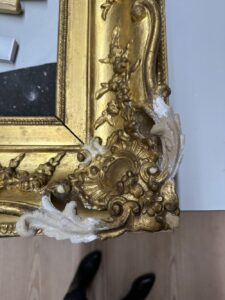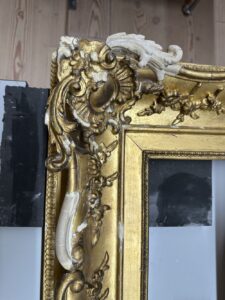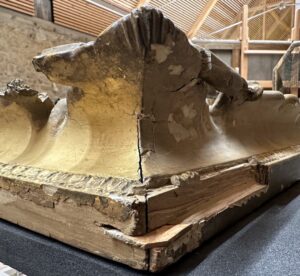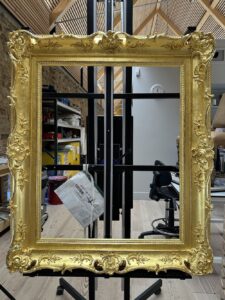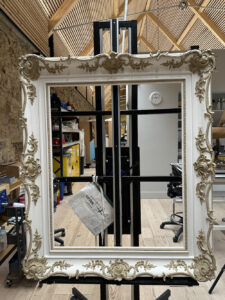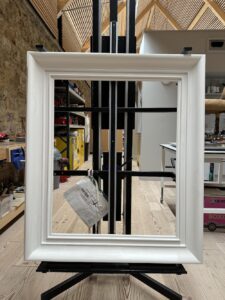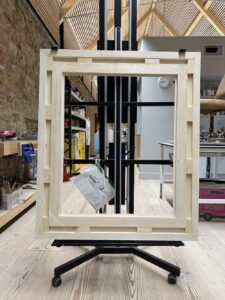Rococo compo frame
Category: Frames



Introduction
The focus of the project was the paired portraits of Agnes and Thomas Molyneux Seel, part of the collection at Oxburgh Hall. The work was carried out at the Royal Oak Foundation Conservation Studio at Knole House, National Trust. The original frame surrounding Thomas’s portrait required conservation, while Agnes’s portrait needed a crafted replica. Both frames were made using “composition,” a traditional method for creating ornate decorative elements, widely used in historical frame-making.
This work carries broader cultural significance, as composition picture frame making is currently listed on the Red List of Endangered Crafts. With few active practitioners and limited opportunities for hands-on training, the continuation of this heritage craft relies on projects like this, which support both conservation outcomes and skills development.
Following research into frames from the period 1820–1830, the decision was made to base the replica on a Rococo style, while adhering to the original frame’s swept-centre and corner baroque-style profile. This approach ensured stylistic cohesion and historical sensitivity.
A complete set of 19th-century Rococo moulds was sourced from Joseph McCarthy Fine Frames Ltd, who generously lent the moulds for the project. These moulds were essential in replicating the ornamentation typical of the period.
The frame-making process began in the studio, where profile mouldings were constructed and joined using traditional hand and modern tools like moulding planes for the ogee curves, a router for shaping the inner frame, and extensive sanding for surface refinement.
Ornamental details were then pressed in composition and applied to the frame. Additional swept sections were cut, and pierced detailing around the ornamentation enhanced the visual lightness and flow of the overall design.
The decorative finish was applied using oil gilding across the majority of the surface. Select inner elements, including the bands and astragals, were highlighted with water gilding to bring contrast and definition. The final stage involved toning the replica to match the historic frame’s aged appearance using wood stains, watercolours, and Gamblin conservation colours.
This project not only brought new life to a pair of important historic portraits but also served as a valuable training experience—allowing for the development of a wide range of practical skills in frame conservation and reproduction and contributing to the continued practice of an endangered heritage craft.
Condition Before Treatment
Condition of Thomas’ frame
The structure was overall stable. There was timber loss on the proper left corner of the top member, and the top proper left mitre joint of the inner frame had a slightly mobile key and timber loss. Although this mitre joint was open, it remained stable due to the keys. Several holes were present across all four members, some containing corroded nails. Splits were observed on both corners of the top member. The frame featured pierced composition ornaments, with some corroded brads and wires visible in areas where fragments were missing. Cracking was evident throughout the composition, particularly along the top edge, and losses were concentrated mainly in the four corners. Some broken fragments were found to be mobile. The surface decoration consisted of both water and oil gilding, with a painted back edge. At some point, the frame had been over-gilded, and the yellow mordant along with the black paint had flecked. Overall, there were losses to the gesso layer, ingrained surface dirt, and areas of flaking. The backing required improvement.
Treatment
Treatment for Thomas’ frame
The structure was stabilised by gluing splits and a loose key. A pine wood fragment was used to complete the top edge corner, adhered with Bencon 22 epoxy resin following a preparatory layer of hide glue. Loose ornamental fragments were reattached using hide glue. Corroded nails and wires visible around broken or loose fragments were mechanically cleaned with a spatula and treated with Hammerite Kurust (a rust converter), followed by the application of Paraloid B72 to prevent further corrosion. Silicone rubber was used to create moulds for casting the missing composition fragments, which were then pressed into the moulds and backed with additional composition. Minor losses were filled with gesso putty. Lifting gesso layers were consolidated with rabbit skin glue. The oil-gilded surface was cleaned using tri-ammonium citrate and rinsed with deionised water. Additions were gilded using the water gilding method, with ochre bole prepared to simulate the existing oil mordant. Habberley Meadows Genuine Gold Leaf 23½ Medium Deep was used for gilding, and the back edge was painted with acrylic paints. Toning was carried out using watercolours and Gamblin colours. Conservation framing was upgraded to provide proper backing for the painting. Felt and gummed tape were applied to the rebate, new balsa wood spacers were cut to fit the painting, and brass strips were used to secure it in place. Finally, Melinex was added to cover the painting.
